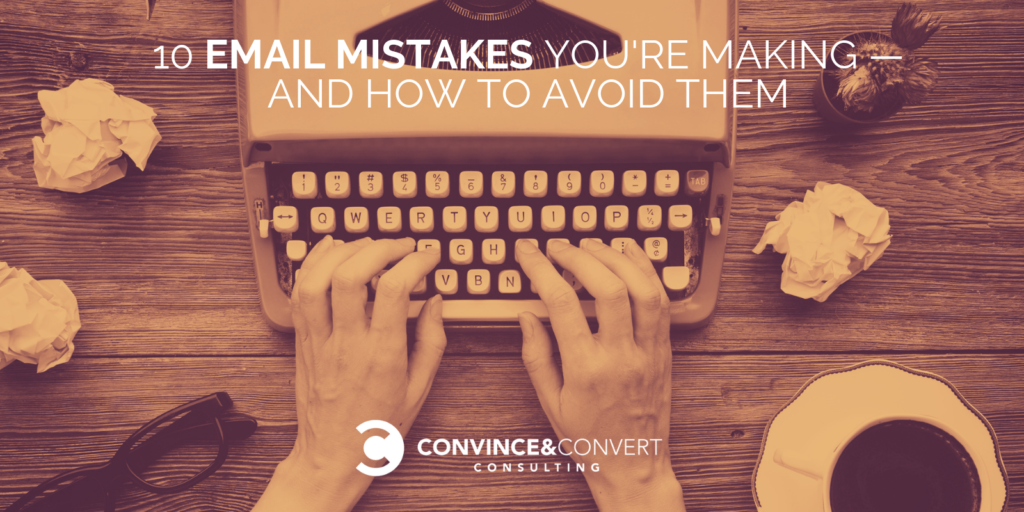
Today’s marketers are in a whole new world, as technology allows you to gather fresh leads online while also improving customer retention. However, poorly designed email campaigns damage reputations and send pitches straight to the spam folder.
Many newbies (and even seasoned marketers) commit common faux pas when deploying emails.
Avoid making 10 of the following common email marketing mistakes to get more people to open your messages and, more importantly, take action that results in increased revenue.
1. Penning Poor Subject Lines
We all receive a ton of email. As a result, many readers simply scan each email subject line for mere microseconds before performing a mass deletion of unwanted sales pitches.
Everyone has seen grandiose subject lines promising the reader they can drop 20 pounds in two weeks or generate six-figure incomes within the next month. Hyped-up email subjects scream spam, and readers often mark them as such to marketers’ dismay. Even when readers avoid labeling a particular sender as spam, proclaiming the impossible makes them roll their eyes and tick the delete box.
Subject lines that compel readers to open them and take action share several characteristics:
- They don’t trick people into opening — they provide value
- They’re short, sweet and to the point
- They focus on the subject while avoiding fluff and filler words
- They’re professional sounding, not sensational
- They’re personalized
- They avoid yelling at the reader in all caps
Busy professionals eschew emails whose subject lines offer no perceived value. Emails deleted unopened due to lackluster titles waste marketers’ time while creating no additional revenue for their efforts.

2. Failing to Utilize Message Previews
Most email programs feature previews that briefly introduce readers to the topics covered in the correspondence. The email preview works a bit like a lead in a news story: Readers want to know if the rest of the content will make for worthwhile reading.
Just as the first line of an article needs to grab the readers’ interest, message previews let prospects know if they want to read further.
Keep this one rule in mind: The first line of any email ranks highest in attention to quality. Even if the content that follows the first line resembles direct mail on par with David Ogilvy’s creative talent, words no one reads sell no products or services.
3. Not Letting Readers Reply
No one looks forward to email correspondence from their apparent good friend named Do Not Reply. Emails that fail to let readers respond and ask any questions they may have lead them to look for more personable organizations to conduct business with. An email from Marisol.Martinez@mybusiness.com gets opened more often than those from an anonymous “Contact.”
Always provide readers with a way to get in touch. If allowing replies grows too overwhelming, integrate a “Contact Us” link that leads potential clients to a well-designed landing page where they can pose inquiries or request further info.
Such pages can also capture additional information from prospects — for example, real estate agents can require contacts to indicate their timeline for buying or selling a home.
4. Coming Across As Shady
Readers today avoid opening emails that contain even a hint of a phishing scam for good reason. Far too many have already fallen prey to scams, while others have read of the dangers in the media. Once a company gains a reputation for misleading marketing messages, repairing the damage can take years, if it happens at all.
Avoid too much hyperbole in email campaigns. Always keep the tone professional and courteous, and go the extra mile by including a privacy notice in each email letting readers know how to unsubscribe.
While no marketer wants to lose even one prospect, the consequences of gaining a reputation as an untrustworthy organization impacts revenue more than a handful of folks unsubscribing for their own personal reasons.
5. Going Crazy With Graphics and Stock Photos
Many consumers today own computers capable of loading image-heavy content quickly, but designing a campaign around nothing but graphics alienates readers and makes the correspondence appear irrelevant.
While the correct use of charts and highlighted sale graphics can increase conversion rates, consider them the spices you add to the main dish of quality content. A little goes a long way, and too much spoils the entire meal.
6. Falling Out of Touch
Far too many marketers either grind too hard with unwanted emails or neglect keeping up contact altogether after launching one or two successful campaigns.
As much as some may love your informative content, letting too much time pass between correspondence distracts their attention elsewhere, and bombarding readers with daily emails when they’ve only signed up for a monthly newsletter exasperates otherwise loyal followers.
Ideally, allow site visitors to indicate their desired update frequency when signing up, and honor their wishes. Automate emails to send at regular intervals even while on vacation or leave to avoid communication gaps.
7. Neglecting Mobile Users
Almost all Americans now own cellphones, and 77 percent utilize smart devices daily. Failing to tailor email campaigns to load properly in iPhone windows results in lost customers and income.
Always beta test email campaigns across a variety of devices to eliminate quality and load time issues. While marketers cannot completely control speed issues caused by older devices or poor network quality, they can design layouts that allow the majority of users to view their content more quickly.
8. Failing to Track Campaigns
Email campaigns need to incorporate tracking programs to identify what messages get potential customers to take action and which ones get sent straight to the computerized recycling bin. Establish a tracking system to continually improve marketing measures and increase conversion rates.
Many CRM software systems include email tracking tools, and savvy marketers utilize the full suite to evaluate campaign effectiveness. It also allows them to target those customers most likely to open their correspondence and entice them with special offers to grow sales.
9. Not Pruning the Branches
Keeping paying customers coming back for more content shares importance with avoiding wasting time on those who never open emails, or worse, report them as spam. Evaluate your customer list on a quarterly basis and delete contacts who never convert.
While eliminating leads seems a dangerous proposition to many marketers, in the long run, those who focus primarily on engaged customers reap higher returns on their email campaign investment. Email unsubscribes are actually a good thing. Each subscriber costs a bit of money, and while the individual amount may seem small, why waste a dime on customers who consistently delete carefully crafted messages?
10. Forgetting a Call to Action
The most important aspect of email marketing campaigns is getting readers to take action and invest in products and services. Effective calls to action focus on the customer, not the product.
Effective calls to action focus on the customer, not the product. Click To Tweet
Create calls to action that center on readers’ needs. Do they need more time in the day? Are they researching the best tax software to prepare a return with several Schedule Cs? Offer solutions without relying on hyperbolic claims.
Creating Email Campaigns That Sell
Email offers an inexpensive way to reach prospective customers, but ill-designed campaigns give would-be clients the impression that a business only wants to take their money while offering little value in return.
Successful campaigns keep customer needs paramount when scripting marketing content and offer real solutions to everyday problems without promising the moon.
By avoiding common mistakes, marketers can target their audience far more effectively than they can with traditional radio and TV spots alone.
- Home page
- Content Marketing
- Digital Marketing Strategy
- Digital Marketing Strategy
- Digital Marketing Strategy
- PPC
- SEO
- Social maketing
- WordPress web development


